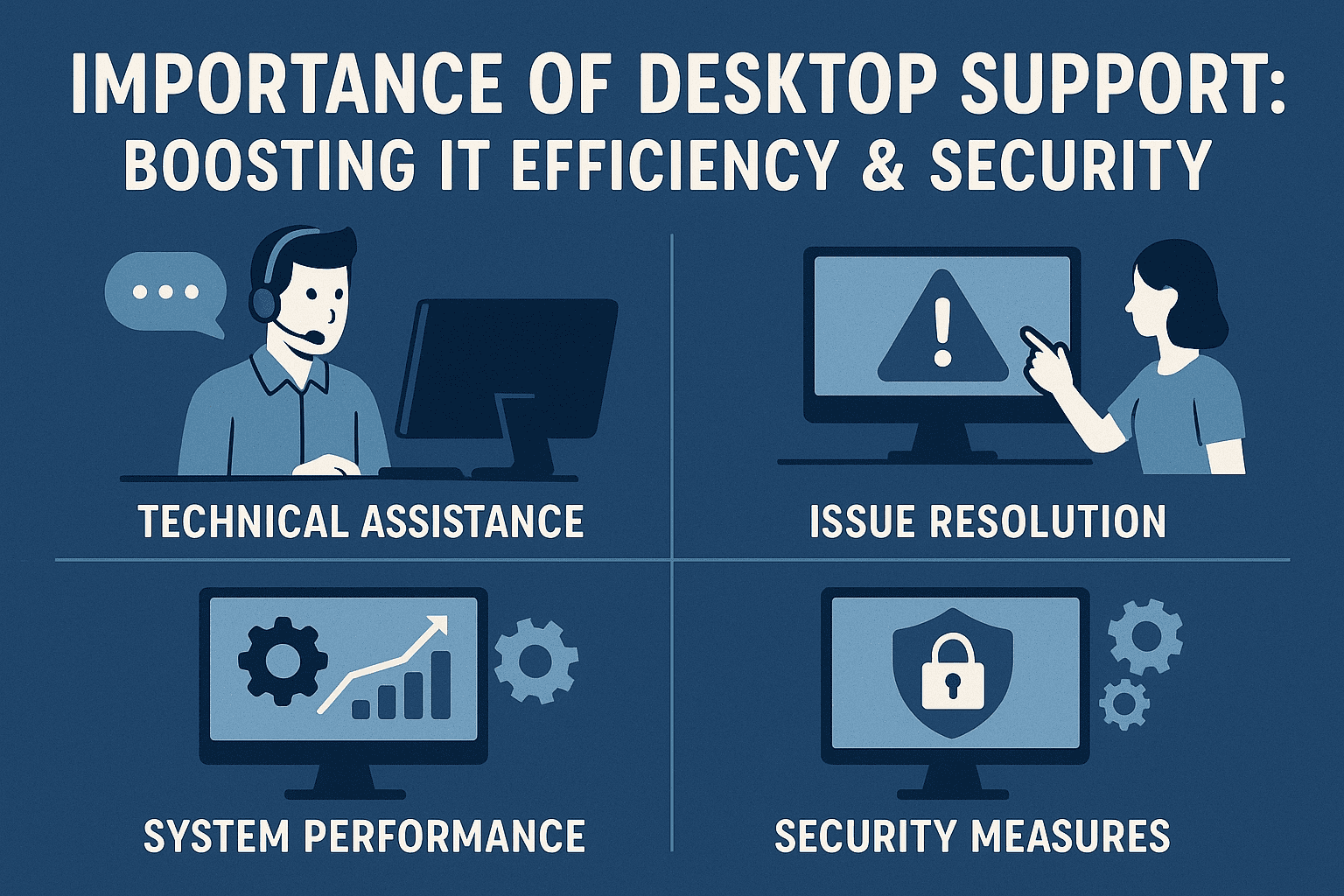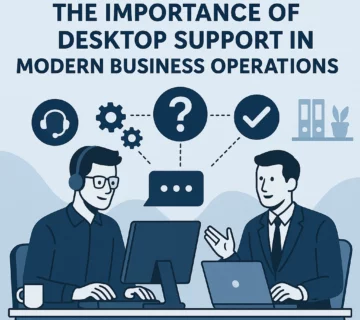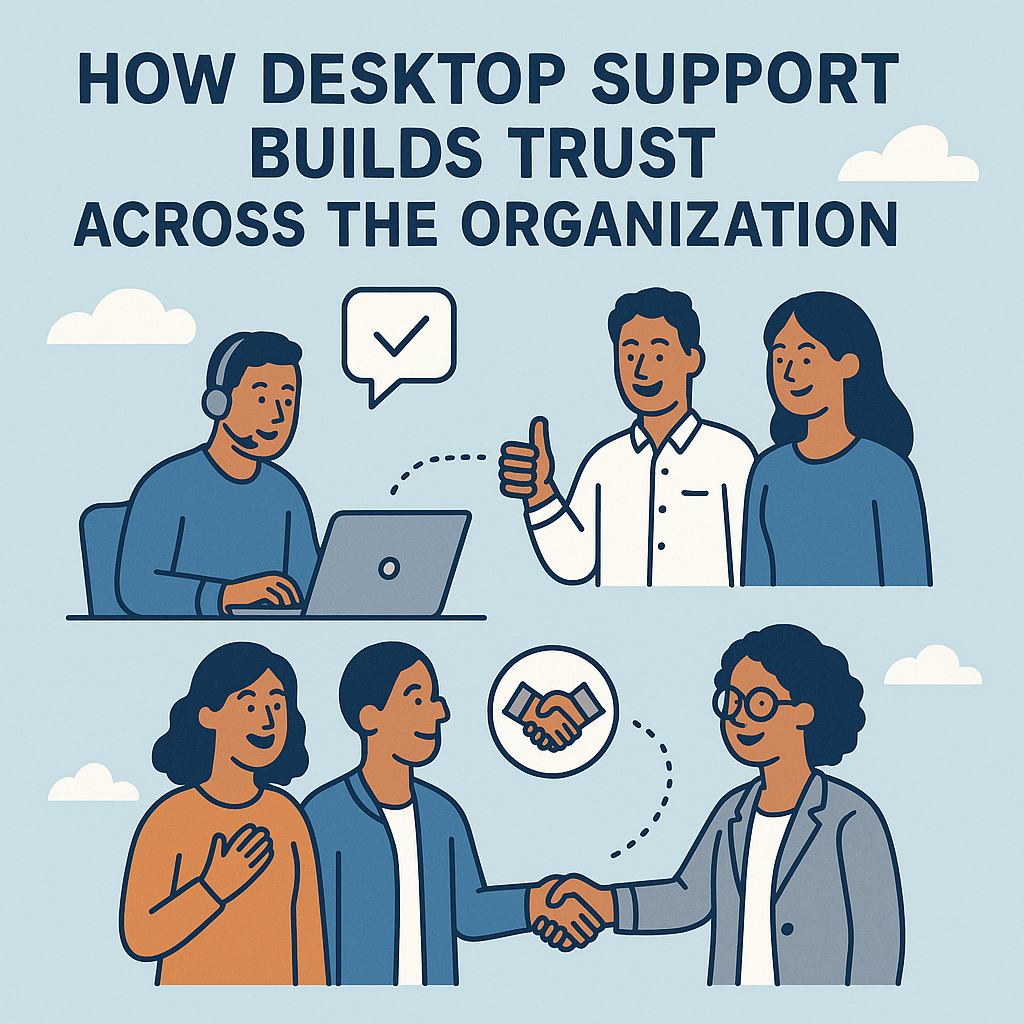Importance of Desktop Support: Boosting IT Efficiency & Security

With today’s rapid digital landscape, having the ability to keep technology operations running smoothly, securely, and efficiently is of the utmost importance for organizations of any size. From finance to healthcare, education to manufacturing, employees in every business count on computers and computer-based systems to carry out their daily work. When these systems fail, productivity grinds to a halt, projects are put behind schedule, and customers can be affected. This is where effective desktop support kicks in assisting with timely technical assistance to end users so business processes keep on running smoothly.
Getting Familiar with the Basics of Desktop Supports
Essentially, the technical assistance provided to end-users when something goes wrong with their computer, programs, or peripheral devices. It may include troubleshooting software issues, fixing hardware failure, dealing with system upgrades, and providing security and productivity best practices advice.
Traditionally, desktop support was viewed as a reactive function users saw that something failed, invoked IT, and waited for the issue to be fixed. Today, however, support teams are proactive. With monitoring tools, automation, and remote access tools, most problems can be discovered and fixed before they hit the end user. This shift indicates the importance of desktop support both as a fixer and as a strategic contributor to overall IT health.
Why Desktop Support is Critical to Businesses
For most businesses, employee productivity is inextricably tied to the health of their handhelds. A crashed laptop, corrupted files, or network issue can quickly translate into lost business or lost opportunities. By ensuring users have stable, continuous access to their digital assets, support teams have a direct influence on business performance.
Some of the most significant benefits include:
Reducing Downtime: Downtime expenses a minute of each dollar. Effective support reduces interruptions and maintains teams on course.
Enhancing Employee Satisfaction: IT frustrations are a morale drag. Quick, reliable service improves the employee experience.
Enhancing Security: With rising cyber threats, frontline support teams are typically the first line of defense against phishing attempts, unauthorized access, or questionable activity.
Standardizing Technology Use: Assistance enables employees to follow organizational standards for software application, device security, and data management.
The Evolution of Desktop Supports
Over the last two decades, the roles of desktop supports has been transformed. In certain environments perhaps manufacturing floors or hospitals much has shifted to remote and hybrid approaches. Advances in technology have allowed IT support teams to assist anywhere. Remote desktop control, cloud monitoring, and artificial intelligence driven troubleshooting are some of the technologies that make it easy for technicians to resolve most problems without being physically present. This improves efficiency but also allows companies to provide support between multiple locations, time zones, or even continents.
Furthermore, the work scope of support teams has expanded. They are now required to assist in mobile device management, cloud app diagnosis, and even collaboration platform optimization. This added scope is a reflection of the more integrated nature of business technology nowadays.
Challenges That Are Most Commonly Faced by Desktop Supports Teams
While important as the task may be, assured support is not free of challenges. Some of the most common challenges include:
High Ticket Volumes
Growing reliance on technology means support teams are dealing with hundreds of requests, ranging from basic password resets to complex system freezes. Prioritization and workflow automation are the keys to the management of these demands.
Remote and Hybrid Work Spaces
With employees distributed geographically, the technicians have to troubleshoot without face-to-face access to the device. This requires effective remote management software and great communication skills.
Rapidly Evolving Technology
New technology, operating systems, and software emerge every day. Support professionals must stay in training to stay current.
Cybersecurity Risks
Ransomware, phishing scams, and other online threats are getting more complicated. Support staff must do more than fix issues they have to educate users on how to reduce risk.
Varying Speed with Care
Customers often expect instant solutions, but some issues require careful investigation. Achieving the right balance is a recurring challenge.
Methods for Constructing Solid Desktop Supports
Businesses can improve IT support actively. Some of the best practices include:
Using Self-Service Portals: All routine issues, such as resetting passwords or software installation, can be automated through portals, allowing technicians to concentrate on more complex work.
Using Remote Tools: Remote monitoring and management tools allow issues to be identified and resolved promptly.
Providing Regular Training: Ongoing upskilling ensures support staff are familiar with fresh technologies and cyber practices.
Hardware and Software Standardization: Reducing hardware and software variation simplifies diagnosis and lowers resolution times.
Issuing Clearly Expressed Fixes: Fixes must be delivered in nontechnical language, avoiding jargon end users find confusing.
Adopting ITIL Methodologies: Standardized methods such as ITIL (Information Technology Infrastructure Library) help standardize service delivery and increase quality.
The IT Support Human Touch
While much of the labor is technically oriented, support teams’ success also depends quite heavily on people skills. Clarity, empathy, and patience are required when dealing with end users in a state of anxiety or frustration over technical issues. Frequently, the manner in which an issue is resolved is as critical as the fix itself.
For example, a frustrated user who cannot find a critical document at the last minute before a meeting with a client will be stressed. A patient, empathetic technician who not only resolves the issue but also soothes the user can make all the difference to the experience. This kind of empathy creates confidence between IT and the broader workforce.
Future Trends in Desktop Supports
In the future, there are a series of trends that are reshaping the support services:
AI and Automation
AI-powered and chatbot software is increasingly capable of resolving common issues in the moment, so less often do human technicians have to be summoned.
Predictive Support
New monitoring technologies will enable IT support personnel to foresee upcoming breakdowns—such as a hard drive space running low—and repair the problem before users even experience it.
Growing Focus on Cybersecurity
With threats on the rise, desktop support personnel will have a growing role in deploying security measures, educating users, and monitoring suspicious activity.
Integration with Collaboration Platforms
Support functions are being built into products like Teams, Slack, and Zoom, so users can engage support without leaving their workflow.
More Remote Support Capabilities
As businesses become more global, support teams must be able to deliver great support in different geographies.
Quantifying Desktop Supports Success
As in all other business processes, IT support should be quantified against certain performance metrics. Typical metrics are:
First Call Resolution (FCR): The ratio of issues fixed on the first contact.
Mean Time to Resolution (MTTR): Average length of time to repair issues.
User Satisfaction Scores: Worker feedback about the quality and value of support.
Ticket Volume Trends: Monitoring demand fluctuations to observe patterns or recurring issues.
Cost per Ticket: Measuring efficiency and utilization of resources.
With the help of these metrics, companies can optimize their procedures, make more efficient resource allocation, and ensure that support does not lag behind business goals.
Conclusion
While often regarded as a backroom activity, desktop supports services is in reality the foundation of organizational effectiveness and resilience. It enables staff to accomplish their work uninterrupted, protects businesses from costly and time-consuming downtime, and underpins security at a critical level. As technology evolves further, support will increasingly expand beyond break-fix fix-it as an active, strategic competency.
Those organizations that invest in robust support infrastructures, equip their personnel with the right tools, and create a culture of continuous improvement will not only keep their IT infrastructure in proper working condition but also empower their personnel to thrive in today’s digital era. In doing this, desktop support is not merely an elementary technical task but an actual business success driver.




No comment